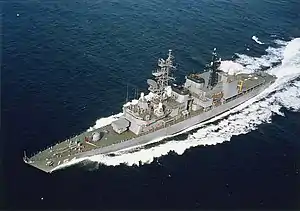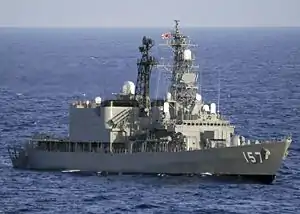 JS Umigiri | |
| Class overview | |
|---|---|
| Name | Asagiri-class destroyer |
| Builders | |
| Operators | |
| Preceded by | Hatsuyuki class |
| Succeeded by | Murasame class |
| Built | 1986–1989 |
| In commission | 1988–present |
| Completed | 8 |
| Active | 8 |
| General characteristics | |
| Type | General-purpose destroyer |
| Displacement |
|
| Length | 137.0 m (449 ft 6 in) |
| Beam | 14.6 m (47 ft 11 in) |
| Draft | 4.5 m (14 ft 9 in) |
| Depth | 8.8 m (28 ft 10 in) |
| Propulsion |
|
| Speed | 30 knots (56 km/h) |
| Range | 6,000 nmi (11,000 km) at 20 kn (37 km/h) |
| Complement | 220 |
| Sensors and processing systems | |
| Electronic warfare & decoys |
|
| Armament |
|
| Aircraft carried | 1 × SH-60J/K anti-submarine helicopter |
The Asagiri-class destroyer (あさぎり型護衛艦, Asagiri-gata-goei-kan) is a class of destroyer, serving with the Japan Maritime Self-Defense Force (JMSDF). It was the second class of first-generation general-purpose destroyers of the JMSDF.[1]
Background
The JMSDF started construction of a Hatsuyuki-class destroyer since FY1977. This was the first class of general-purpose destroyers (汎用護衛艦, Hanyou-goei-kan) under the eight ships / eight helicopters concept.[1] In this concept, each flotilla would be composed of one helicopter destroyer (DDH), five general-purpose destroyers (DD), and two guided-missile destroyers (DDG).[2]
However, due to constraints such as budget, the design of the Hatsuyuki class was compelled to compromise in terms of C4I function, resistance, and durability. Thus, destroyers to be built after FY1983, Asagiri class were changed to an evolved design with expanded hull and enhanced equipment.[1]
Design
The hull is an enlarged type of Hatsuyuki class, and the hull form is of the shelter deck style. Also, as the latter batch of the Hatsuyuki class, the upper structure is made of steel, but since it was incorporated into the design from the beginning, the adverse effect on the movement performance was solved.[1]
The engine room was greatly renovated. Instead of the COGOG propulsion system of the Hatsuyuki class, this class has the COGAG propulsion system with four Kawasaki-Rolls-Royce Spey SM1A gas turbines. With these powerful engines, it was possible to run at 26 knots (48 km/h; 30 mph) by driving only two of the four engines, and the benefits of tracking a submarine were especially great. An alternating arrangement was introduced to improve resistance and durability, as in the steam turbine driven destroyers.[1]
Equipment
The earlier batch was equipped with the OYQ-6 combat direction system (CDS). This system employed one AN/UYK-20 computer as the same as the OYQ-5 tactical data processing system of the Hatsuyuki class, but with expanded memories, it can exchange tactical data via Link-11, which the OYQ-5 does not support. Later, all OYQ-6 systems were upgraded to the OYQ-7, integrated with the OYQ-101 ASW Direction System.[1] All ships of this class were later retrofitted with the terminal for the MOF system, the key operational C4I system of the JMSDF which uses the Superbird SHF-SATCOM.[3]
The surface-search radars were replaced by OPS-28. The air-search radars were updated to OPS-14C in the earlier batch, and in the latter batch, OPS-24 3D radars were introduced. This was a maritime version of the land-based J/FPS-3 early-warning radar, and first shipboard active electronically scanned array radar in the world. In the latter batch, electronic warfare support measures systems were also replaced by NOLR-8, completely newly developed with emphasis on anti-ship missile defense.[1]
Its weapon system is basically the same as the Hatsuyuki class except for the minor change on its FCS. However, a new SH-60J was installed as a shipboard helicopter, so a large capacity data link device was installed. The hangar is enlarged in order to accommodate two helicopters, but only one helicopter is used operationally.[1]
Ships in the class
Yamagiri and Asagiri have been converted into training vessels.
| Pennant no. | Name | Laid down | Launched | Commissioned | Builder | Home port | Note |
|---|---|---|---|---|---|---|---|
| DD-151 TV-3516 | Asagiri | 19 September 1986 | 1988 | IHI Corporation, Tokyo | Maizuru | Converted to training vessel (TV-3516) on 16 February 2005 re-converted to DD-151 in March 2012 | |
| DD-152 TV-3515 | Yamagiri | 10 October 1987 | 1989 | Mitsui, Tamano | Yokosuka | Converted to training vessel (TV-3515) on 18 March 2004, re-converted to DD-152 in March 2011 | |
| DD-153 | Yūgiri | 21 September 1987 | 1989 | Sumitomo Heavy Industries Uraga Shipyard | Yokosuka | On 4 June 1996 accidentally shot down a USN A-6E Intruder, during a live-fire CIWS exercise (part of RIMPAC '96). The two aviators ejected safely, and they were rescued by Yūgiri. Though a malfunction in the Phalanx CIWS was initially implicated as the cause of the incident, human error was later blamed.[4][5] | |
| DD-154 | Amagiri | 9 September 1987[6] | 28 February 1989[6] | IHI Corporation | Yokosuka | ||
| DD-155 | Hamagiri | 4 June 1988 | 1990 | Hitachi, Maizuru | Ominato | ||
| DD-156 | Setogiri | 12 September 1988 | 1990 | Hitachi, Maizuru | Maizuru | ||
| DD-157 | Sawagiri | 25 December 1988 | 1990 | Mitsubishi Heavy Industries Nagasaki Shipyard | Sasebo | ||
| DD-158 | Umigiri | 11 September 1989 | 1991 | IHI Corporation | Kure |
 JS Asagiri (DD-151)
JS Asagiri (DD-151) JS Yamagiri (DD-152)
JS Yamagiri (DD-152) JS Yūgiri (DD-153)
JS Yūgiri (DD-153) JS Amagiri (DD-154)
JS Amagiri (DD-154)_in_the_Sea.jpg.webp) JS Hamagiri (DD-155)
JS Hamagiri (DD-155)_in_the_Pacific%252C_-16_Nov._2007_a.jpg.webp) JS Setogiri (DD-156)
JS Setogiri (DD-156) JS Sawagiri (DD-157)
JS Sawagiri (DD-157) JS Umigiri (DD-158)
JS Umigiri (DD-158) The hangar deck of JS Umigiri (DD-158)
The hangar deck of JS Umigiri (DD-158) JS Asagiri (TV-3516)
JS Asagiri (TV-3516)
References
- 1 2 3 4 5 6 7 8 Kōda 2015, pp. 188–207.
- ↑ Kōda 2015, pp. 167–169.
- ↑ Yamazaki 2011.
- ↑ Watanabe, Teresa (5 June 1996). "Japanese Ship Accidentally Downs U.S. Jet". Los Angeles Times. Archived from the original on 2021-06-05. Retrieved 5 June 2021.
- ↑ Newdick, Thomas (4 June 2021). "The Last Time A Japanese Warship Shot Down A U.S. Navy Plane Was Actually Not So Long Ago". The Drive. Archived from the original on 2021-06-04. Retrieved 5 June 2021.
- 1 2 "Asagiri class Destroyer – DD". seaforces.org. Retrieved 11 December 2014.
Bibliography
- Kōda, Yōji [in Simple English] (December 2015). "History of Domestic Built Destroyers of JMSDF". Ships of the World (in Japanese). Kaijin-sha (827). NAID 40020655404.
- Wertheim, Eric (2013). The Naval Institute Guide to Combat Fleets of the World, 16th Edition. Naval Institute Press. ISBN 978-1591149545.
- Yamazaki, Makoto (October 2011). "Combat systems of modern Japanese destroyers". Ships of the World (in Japanese). Kaijin-sha (748): 98–107. NAID 40018965310.
External links
 Media related to Asagiri class destroyers at Wikimedia Commons
Media related to Asagiri class destroyers at Wikimedia Commons- GlobalSecurity.org; JMSDF DD Asagiri Class